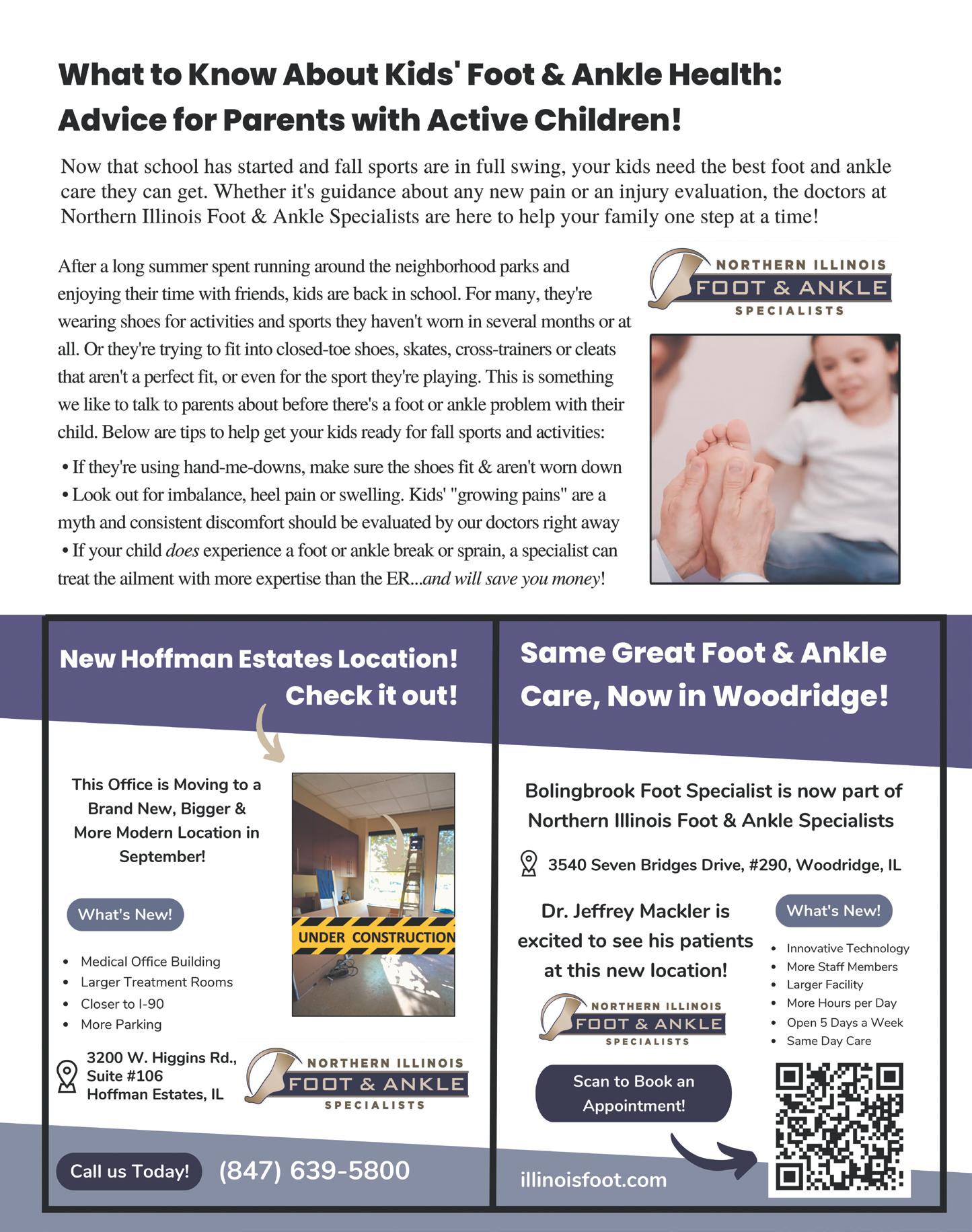
7 minute read
family wellness
Expert Medical Advice about GOING BACK TO SCHOOL
By Cheryl Maguire
Advertisement
Do I have to wear a mask again this school year?”
My 12-year-old daughter asked me this question when we recently discussed going back to school. This question along with many others are being asked by kids since the rules about the pandemic are always changing
I want to make sure my daughter is healthy and ready for school, so I turned to a medical expert to learn more about masks, immunizations, and check-ups before returning to school this fall.
SCHEDULE A CHECK-UP OR WELL VISIT
If your child has not already had their yearly check-up it is important to schedule one so that they can remain healthy throughout the school year. During this visit, you and your child can also discuss any mental health concerns.
Dr. Damon Korb, a developmental-behavioral pediatrician in Los Gatos, CA, and author of Raising an Organized Child says “Think of going back to school, the same way that you would have any year but perhaps it is more important. We do not want to miss a potential problem to avoid another. Children should get all of their normal well visits and immunizations.”
IMMUNIZATIONS AND FLU SHOTS
Dr. Korb recommends referring to the immunization schedule recommended by the CDC to make sure your child is up to date. Sumana Reddy M.D. at Acacia Family Medical Group in Salinas, CA says that everyone should make sure that they get a yearly flu shot. Flu shots are normally available starting in September. And it’s also important to get a covid vaccine if your child hasn’t received one yet.
“Children can die from the flu. It’s very important to get your flu shot,” says Dr. Reddy. Dr. Korb agrees by saying, “Getting the flu shot may actually reduce the likelihood of catching and spreading covid.”
Dr. Reddy explains that most doctors are concerned about people being infected with the combination of covid and the flu virus that will be circulating this fall. “The more families that get the flu vaccine the better it will be for everyone,” she says. Unlike most vaccines, you need to get the flu shot yearly for it to be effective since the strain of flu often changes.
If you don’t have insurance vaccines will be provided for free by doctors due to the federally funded program Vaccines For Children. The program provides vaccines to children who might not be vaccinated because of an inability to pay. The vaccines are available at private physicians’ offices and public health clinics registered as VFC providers.
And if you do have insurance there should not be a co-pay for receiving the vaccine.
“The Affordable Care Act requires private insurance companies to pay in full for vaccines recommended by the CDC,” says Dr. Reddy.
Dr. Reddy explains that there might be some insurance companies that are exempt and that you should check with your insurance company about coverage before getting your vaccine.

Children might be unaware of the fact their vision is not normal. This may lead to feeling frustrated about being unable to see the words in a book or in the classroom causing a child to act out.
The CDC recommends that children’s eyes should be checked regularly by an eye doctor or pediatrician. Amblyopia or lazy eye is the most common cause of vision loss in children which can be treated if caught early between the ages of 3 to 5 years old. The American Optometric Association estimates 80% of a child’s learning happens through observation. In the classroom, most of the teaching is done by displaying the information. The American Academy of Pediatrics recommends that your child visit a dentist for an initial check-up by the time they turn one. According to the CDC tooth decay (cavities) is one of the most common chronic diseases for kids from ages 6 to 19. Research studies found that children who have poor oral health often miss more school and receive lower grades than children who have good oral health.
Fluoride can prevent about one-third of cavities in baby teeth. If your town water does not contain fluoride, you can ask your pediatrician or dentist to prescribe fluoride which is typically taken in pill form once a day. Kids that are going back to school might have anxiety about this transition from summer break. “I recommend that all kids do a telehealth check-in with their pediatrician to discuss the transition. Often parents think their kid is fine, but you want to have a chance to talk about stress and anxiety,” says Dr. Reddy. During this check-in, you can also make sure that your vaccines are up to date or talk about any other mental health concerns.
BE A ROLE MODEL
Dr. Korb says, “Make sure you prepare your child by teaching and modeling safe behavior such as frequently washing hands.”
Jump-Start Success at School with Wellness at Home
Setting the stage for success in the classroom starts with reliable morning routines the whole family can depend on. Establishing a plan for each day before heading off for work or school is beneficial for staying on time and organized, and many families’ mornings start with a nutritious breakfast.
This school year, add better-for-you breakfast recipes like Orange Oatmeal or an Orangeberry Smoothie to the menu. These morning meals are powered by 100% orange juice, a delicious option that helps fuel the body with essential nutrients that support a healthy immune system and overall diet quality with no added sugar.
“A growing number of research studies has revealed children who regularly drink 100% orange juice have higher intakes of key nutrients, higher quality diets and may have healthier lifestyle habits, like greater physical activity levels, than children who do not drink OJ,” said Dr. Rosa Walsh, director of scientific research at the Florida Department of Citrus. “Study after study confirms that 100% orange juice not only has a place in the diets of children, but it can also serve as an easy way for parents to provide key nutrients without fear of adverse effects on body weight when served in moderation.” Consider these nutritional benefits of Florida Orange Juice, “The Original Wellness Drink.”

Diet Quality
Because 1 cup of 100% orange juice counts as 1 cup of fruit, it’s an easy way to contribute to your children’s fruit intake. As a kid-favorite, it’s a nutrient-dense beverage that helps increase the intake of key nutrients including vitamin C, folate, thiamin, magnesium, potassium and, in fortified juices, vitamin D and calcium.
Immune Support
When paired with a healthy lifestyle, Florida Orange Juice has vitamin C, vitamin D (in fortified juices) and phytonutrients (naturally occurring plant compounds) and may help support a strong immune system. • Vitamin C – Commonly associated with helping maintain and strengthen a healthy immune system by protecting cells and promoting the production and function of cells. One 6-8-ounce glass of OJ is an excellent source. • Vitamin D – Plays an important role in regulating immune response and helps cells fight off bacteria and viruses that get into the body. One 6-8-ounce glass of fortified OJ is a good source. • Plant Compounds, Flavonoids and Colorful Carotenoids – Work to support the immune system by helping to fight inflammation and helping cells communicate with each other, which can help strengthen immune response when encountering infection. No Added Sugar
Unlike foods and beverages that contain added sugars, the natural sugar in 100% orange juice contains vitamins, minerals and phytonutrients. As one of nature’s nutrient-rich foods, OJ is a convenient way to enhance whole fruit intake and reach daily recommendations. Plus, it can be used as a substitute for nutrient-poor foods and beverages, such as sugar-sweetened beverages, in the diets of children and adults. Find more information and recipe inspiration at FloridaCitrus.org/OJ.
Orange Oatmeal
Servings: 4 1½ cups water 1 cup Florida Orange Juice 1 cup quick cooking steel-cut oats 1 Florida Orange, peeled and diced 1 tablespoon agave nectar or honey 1/4 teaspoon cinnamon 1/4 teaspoon salt In medium saucepan over high heat, bring water and orange juice to boil. Add oats to boiling liquids. Return to boil then reduce to medium heat and cook uncovered 5 minutes, stirring frequently. Mix in orange, agave nectar, cinnamon and salt. Remove pan from heat; let stand 1 minute before serving.









